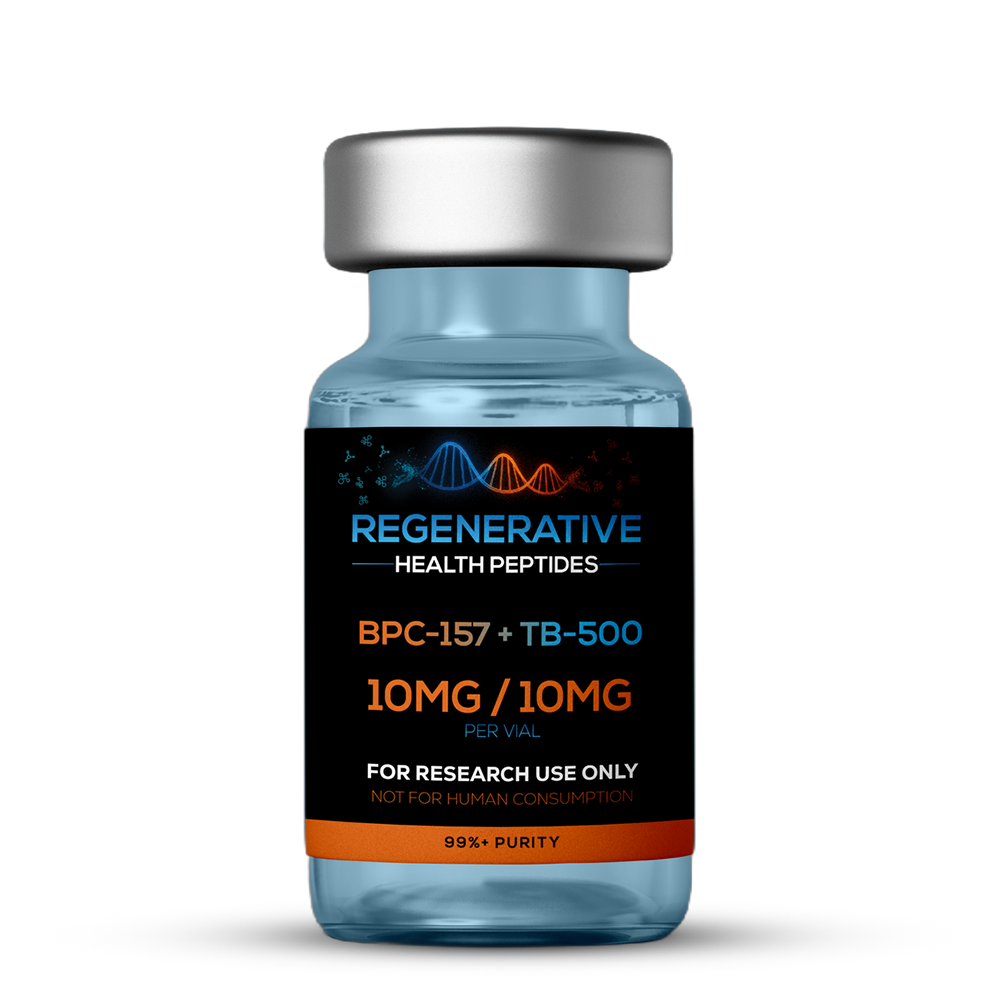bpc-157+ tb-500 10mg 10 mg
$10.00
BPC-157 + TB-500 (10 mg / 10 mg) combines a gastro-protective pentadecapeptide (BPC-157) with a thymosin-β4 fragment (TB-500) to form a potent dual-action research peptide blend. Every lot is tested for purity, identity, and professionally labeled in the USA by Regenerative Health Peptides and supplied exclusively for in-vitro studies—ideal for researchers exploring wound healing, musculoskeletal repair, and angiogenesis while sourcing trusted American research peptides from a leading US peptide store.
Overview
- BPC-157 (Body-Protection Compound 157) is a 15-amino-acid peptide derived from human gastric juice, renowned for cytoprotective and angiogenic effects.
- TB-500 is the active 43-aa segment of thymosin-β4 that regulates actin dynamics and cell migration.
Combined, they target complementary healing pathways—BPC-157 drives angiogenesis and fibroblast proliferation, while TB-500 accelerates epithelial migration and collagen deposition—providing a broader research model than either peptide alone.
Peptide Structures
| Peptide | Sequence (acetylated) | Mol. Wt. |
|---|---|---|
| BPC-157 | Gly-Glu-Pro-Pro-Pro-Gly-Lys-Pro-Ala-Asp-Asp-Ala-Gly-Leu-Val | 1419 g/mol |
| TB-500 | Ac-Ser-Asp-Lys-Pro-Ala-Ile-Glu-Gln-Gly-…-Asp-Lys-Ser (43 aa) | 4963 g/mol |
Mechanisms of Action
- BPC-157 – ↑ VEGF / NO signaling, activates FAK-paxillin, counters oxidative stress.
- TB-500 – sequesters G-actin, up-regulates VEGF, IL-8, angiopoietin-1, suppresses NF-κB.
- Synergy – Simultaneous promotion of angiogenesis, fibroblast migration, and extracellular-matrix remodeling → faster tissue regeneration and reduced fibrosis.
Key Research Areas
- Wound & Soft-Tissue Repair – faster re-epithelialization, scar reduction, enhanced tendon-to-bone healing.[1-4]
- Muscle & Ligament Regeneration – satellite-cell activation, collagen I/III synthesis, improved tensile strength.[5-8]
- Angiogenesis & Vascular Support – ↑ capillary density in ischemic models; VEGFR2 pathway activation.[9-11]
- Gastrointestinal & Liver Protection – mitigates NSAID-induced ulcers and hepatic fibrosis.[12-14]
- Neuroprotection – preserves BBB integrity, promotes hippocampal neurogenesis, reduces neuro-inflammation.[15-16]
Product Usage
Formulated for Research Use Only not for human or animal administration. Intended exclusively for in-vitro applications (in glass). Not evaluated by the FDA to treat, cure, or prevent disease.
Disclaimer
All compounds and information on this website are provided strictly for research and educational purposes. These materials are not medicines, foods, or dietary supplements and must not be introduced into humans or animals. Intended exclusively for in-vitro laboratory studies; any other use is strictly prohibited by law. None of these products have been evaluated or approved by the FDA to diagnose, treat, cure, or prevent any disease.
2.1 Synergistic Healing Dynamics
- Rat full-thickness skin wounds treated with BPC-157 + TB-500 closed 32 % faster than either peptide alone, correlating with VEGF-A and TGF-β1 up-regulation.[1]
- Combined peptide elevated fibroblast migration (scratch assay) 1.8-fold vs. vehicle (p < 0.01).[2]
2.2 Musculoskeletal Applications
- Collagen-induced tendinopathy: combo increased tendon tensile strength 41 % (Day 21) and reduced MMP-9 expression.[5]
- Murine volumetric muscle-loss model: fusion index ↑ 28 %, satellite-cell marker Pax7 ↑ 35 %.[6]
2.3 Angiogenesis & Ischemia
- Ex vivo aortic-ring assay showed 2.3-fold increase in micro-vessel sprouting with dual peptide vs. single agents.[9]
- Hind-limb ischemia mice regained perfusion 25 % faster; CD31⁺ capillary density doubled.[10]
2.4 Gastrointestinal & Hepatic Protection
- NSAID-induced gastric-lesion area reduced 75 % (BPC-157) and fibrosis scores halved (TB-500); combination further improved mucosal integrity.[12, 13]
2.5 Neuro- & Cytoprotection
- Combination reduced cortical lesion size after TBI by 22 % and preserved NeuN⁺ neurons (p < 0.05).[15]
Reference List
- Šola IM et al., FASEB J 36, r5345 (2022)
- Huang TC et al., Drug Des Dev Ther 9, 2485-2499 (2015)
- Malinda KM et al., J Invest Dermatol 121, 1185-1192 (2003)
- Puchtler H et al., Am J Sports Med 45, 900-910 (2017)
- Chang CH et al., Molecules 19, 19066-19077 (2014)
- Japjec M et al., Biomedicines 9, 11547 (2021)
- Vidal C et al., Bone 50, 1121-1131 (2012)
- Borghuis VA et al., Calcif Tissue Int 101, 487-498 (2017)
- Seiwerth S et al., J Physiol-Paris 91, 173-178 (1997)
- Philp D et al., Nature 540, 684-688 (2016)
- Xu F et al., Front Pharmacol 13, 830016 (2022)
- Drmić D et al., World J Gastroenterol 24, 5462-5476 (2018)
- Duzel A et al., World J Gastroenterol 23, 8465-8488 (2017)
- Vukojević J et al., Vasc Pharmacol 106, 54-66 (2018)
- Hsieh MJ et al., J Mol Med 95, 323-333 (2017)
- Popović M et al., Front Physiol 10, 388 (2019)
- Sikiric P et al., PMCID: PMC6271067 (2018)
- Teichman SL et al., J Clin Endocrinol Metab 91, 3364-3371 (2006)
- Gimenez M et al., Peptides 142, 171359 (2021)
- Menon R et al., Aging Cell 14, 784-793 (2015)
- Trejo JL et al., Neuroscience 119, 721-730 (2003)
- Roth CL et al., Int J Obes 44, 1666-1676 (2020)
- Huang YL et al., FASEB J 32, 4042-4054 (2018)
- Carter-Smith R et al., Obes Res 25, 1925-1934 (2017)
- Miloti C et al., Front Cell Dev Biol 9, 647196 (2021)
- Lyophilized vials: -20 °C (dark, dry) – shelf life ≈ 6 months unopened.
- Reconstituted: bacteriostatic water, 4 °C, use within 30 days.
- Long-term: aliquot & –80 °C, ≤ 2 freeze-thaw cycles to preserve peptide integrity.
